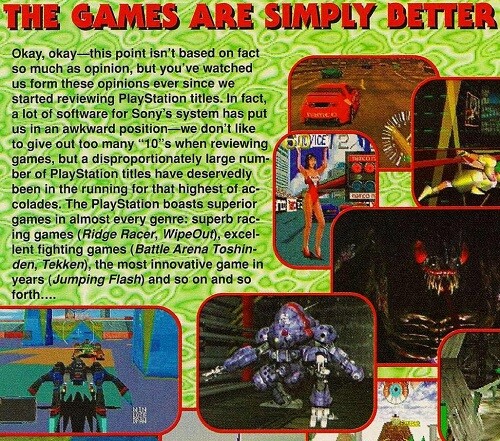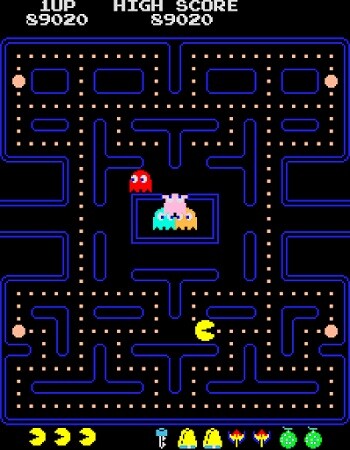The '90s Officially Turned Gaming Into A Pop-Culture Fixture

The 1990s were an intensely specific historical moment – the Cold War had just ended, everybody had landlines, and pre-internet peoples took to local forests to harvest their precious smut. This week, Cracked's taking a look back at those artifacts of Nineties culture and how they shaped our present. Check out part 1.
For a while in the '80s, it really looked like the hopes and dreams of the video game industry would end up buried in a landfill in New Mexico like some double-crossed mobster. How did gaming go from a passing hobby for children and weirdos to a permanent part of the pop-culture landscape? The answers are long and complex but can be summed up as "the '90s happened." That was the decade when gaming (apologies in advance) leveled up in the public consciousness via trends like ...
In The '90s, Games Became Simpler, Slicker ... And Sexier
Don't Miss
Anyone who says video games used to be simpler has never spent an hour typing arcane words into a blank screen to get a damn DOS game running. If your platform of choice involved loading the games from cassette tapes, then you had to add 15 extra minutes of sitting there listening to screeching noises only to get the dreaded "read error" at the end and have to start all over again. Once you finally managed to access the goddamn game you paid for, your reward was having to figure out which of the pixels on screen was your guy and what the hell you were supposed to do.

20th Century Studios
When the NES came along in the mid-'80s, it caused all other gaming platforms to get thrown into a closet simply by being easier to use and nicer to look at. And that was just the beginning. The change in graphics and usability that took place between 1989 and 1996 is probably the greatest leap the video game industry will ever see, and it's hard to explain its impact to those who weren't conscious back then. Sports games actually looked like the sport they represented! People looked like people! Boobs looked like boobs! Or something like them, anyway.

Eidos Interactive
And, yes, the boob thing was significant. In the '80s, most attempts to use sex to sell video games were pretty overt. Shelves were filled with titles like Beat 'Em & Eat 'Em, while covers featured male characters holding their raging boners because that's what it took to say "this game is sexy" when your character looks like a bunch of random pixels. The advancements in graphics (and physics) made it possible to create more detailed character models and use them as the selling point without having to spell out the "we're trying to make you horny" part, thus allowing these games to fly under your mom's radar.

Future PLC
The music also evolved from beeps and bops to relatively faithful renditions of popular songs, which opened the doors for some legitimate collaborations with the music industry. Massive acts like Aerosmith and Michael Jackson had their own hit games, and Jackson even wrote (recycled) some tunes for Sonic 3. The addition of full-motion video cutscenes attracted Hollywood stars, too: Wing Commander III scored Mark Hamill as Totally Not Luke Skywalker, while William Shatner graced William Shatner's TekWar with his presence, to the delight of William Shatners everywhere.
By 1993, video games were raking in more money than the film industry -- Street Fighter II alone made $1.5 billion that year, or about half a billion more than Jurassic Park. Of course, games had already out-performed movies a decade earlier, at the height of Pac-Mania, and the gaming industry still crapped the bed a couple of years later. The difference is that this time, game companies had a powerful (and shamelessly commercial) ally on their side ...
'90s Game Magazines Were Perpetual Hype Machines
For those too young to remember, magazines were like websites that you could physically hold in your hands and use to kill mosquitos. Video game-related magazines have been around since the '70s, but the earliest ones were more like catalogs than entertainment -- they were packed with articles, novel-length strategy guides, listings for all gaming-related resources imaginable, actual programs you could type into your home computer, and just a crapload of useful information in general.

But then, in 1988, Nintendo of America decided to start publishing its own magazine as "a marketing vehicle" and stumbled upon the formula every '90s mag would follow. The only reason Nintendo Power existed was to show you some rad-ass Nintendo games and get you to pester your parents about them, so the magazine's content was designed around that idea -- the cool games would get their screenshots plastered all over the magazine's various sections while the turds were relegated to a blurb here and there. If a game made it to the cover of Nintendo Power, you could trust that it was gonna be dope.

Nintendo
The reviews themselves were not as biased as you might think, but they were secondary to the magazine's main mission, which was just getting your eyeballs on the games. The original Pokemon Red and Pokemon Blue got a mere 7.2 on their review (IGN would get death threats if they did that today), but the games still got plenty of exposure via previews, reviews, comics, and a mini-magazine that ran as an insert for six months, on top of the traditional ad pages. Incidentally, the magazine didn't even have outside ads until 1998 because the magazine was the ad.
Nintendo Power's colorful, kid-friendly, perma-hyped format turned out to be pretty successful, so other publishers started imitating it. A mag like VideoGames: The Ultimate Gaming Magazine could have more than 50 pages of ads in between 75 pages of content, though it could be hard to tell the latter apart from the former. Right before the original PlayStation came out in the U.S., they put out an article about why it was basically the greatest invention in the history of mankind; even the magazine's executive editor called it "a total propaganda piece."

What's shocking is that VideoGames wasn't even being paid off by Sony -- for the official PlayStation propaganda, you had to turn to Official PlayStation Magazine, not to be confused with Independent PlayStation Magazine, which later became PlayStation: The Official Magazine. Sega's consoles also had their own official and unofficial PR pieces. Nintendo had proved that hyping the hell out of gaming products was a viable business model in itself, so everyone wanted a piece of that action.
These magazines trained information-starved '90s kids to believe that the greatest game of all time is always just about to come out because that's what sold issues, but that's an attitude that ended up outliving the magazine industry. In fact, their greatest legacy is that ...
It Was The Start Of The "Gamer" Identity (For Better Or Worse)
One reason it was so easy for the gaming industry to fall apart in the early '80s is that the "gamer community" as we know it wasn't a thing. The stoner kid playing Asteroids at the arcade had no connection whatsoever to the little nerd typing out a code for the same game into his home computer. Playing games was just another thing young people did to pass the time, like listening to music or loitering outside the local Arby's, and when most games started sucking, they just moved on to other endeavors (probably crack-related, because it was the '80s).

Namco
Also, remember that this was before the internet -- today, you can type any niche interest into Reddit and find a dozen rival communities devoted to it, but there was no such thing back then. If you wanted to interact with other gaming enthusiasts, your options were: A) your little brother or B) that kid at school who swears you can get a million points by making Mario punch Donkey Kong in the taint.
Then, gaming magazines came along and changed that ... out of filthy, capitalistic self-interest, but still. In the '90s, magazines encouraged as much reader participation as possible because asking kids to write in their favorite games was way easier than getting a bunch of them in the office for a focus group. Before the advent of online gaming, magazines were the only way players could communicate with each other on a mass scale, even if it was mainly through crappy fan art.

The magazines' teenager-centric tone and massive reach helped shape the "gamer" identity, which was an instrumental step to cementing gaming as something more than a casual hobby. On the one hand, it's impressive that these things managed to create a lasting sense of community while trying to sell copies of Bubsy and Pepsi Man. But on the other, it's kind of depressing to realize how much of the shared "gamer" identity (the undying hype for that perfect game just over the horizon, the rabid partisanship to one platform or another, the "edgy teen circa 1994" sense of humor, etc.) was intentionally devised by advertising execs.
Ironically, gaming magazines also shepherded their readers into the internet, the same technology that ended up rendering them redundant (not that gamers wouldn't have figured out such a thing existed sooner or later). Once online gaming took off, it was finally possible for players to interact exclusively through the games, with no need for middlemen, and there was no turning back. Nothing can kill gaming now. Except for VR porn, maybe. Especially if they get cone-chested Lara Croft on it.
Maxwell Yezpitelok co-runs a Nintendo-centric YouTube channel, NintendoDuo.
Top image: Eidos Interactive
For more Cracked deep dives, be sure to check out:
MCU WEEK:
The 'Avengers' Comic That Basically Created The Modern Superhero Movie
Why Marvel Studios Is Branching Out Beyond Superheroes-- Sort Of
Marvel's Long And Confusing Path To Figuring Out Television
How Marvel Handles 'Black Panther' Is A Heartbreaking Task
All of the New Marvel Characters Getting Set Up In Phase 4
The Long, Stupid Road To A Watchable ‘Fantastic 4’ Movie
SUPERMAN WEEK:
4 Reasons Anyone Who Says 'Superman Is A Boring Superhero' Is Full Of It
4 Reasons O.G. Superman Is Even More Relevant Today
5 Superman Stories That Are Canon Kryptonite
4 Ways 'Death Of Superman' (Accidentally) Changed Pop Culture
4 Superman Movie Scenes That Were Dumb AF In Retrospect
JOKER WEEK:
The Early Obstacles On Joker's Path To Comic Icon
Why Do We Even Have Batman Movies Today? The Joker.
No One Was Ready For Mark Hamill's Joker ... Least Of All Mark Hamill
That Time DC Comics Turned The Joker Into David Bowie
A Dark Knight's Tale: How Heath Ledger Created A 21st Century Joker
The Weird Confusing Tale Of The Most 'Huh?' Movie Joker: Jared Leto
'Joker' Made A Billion Dollars, And That's Too Much Money To Ignore
